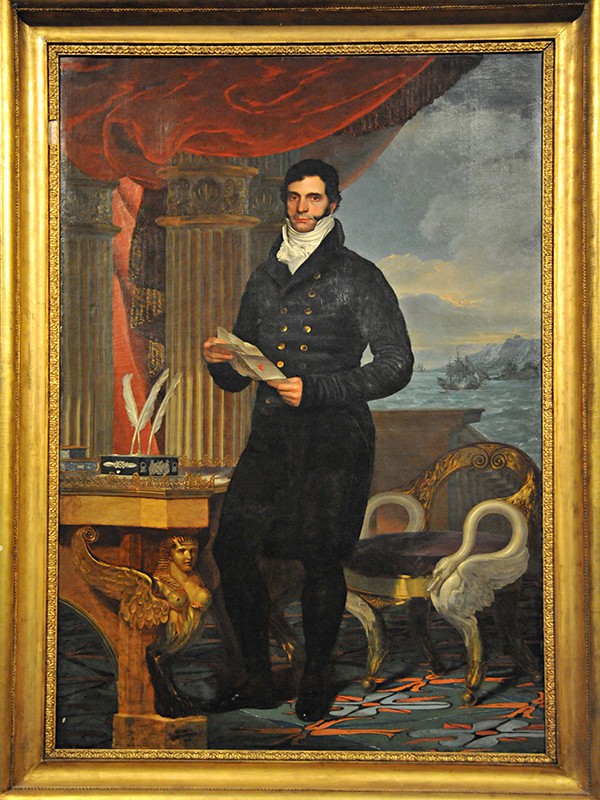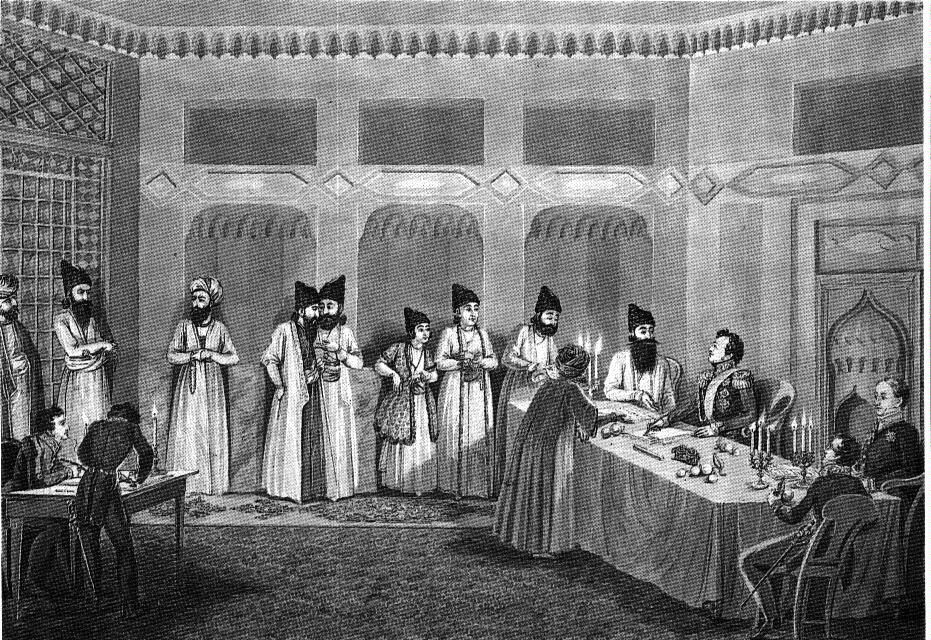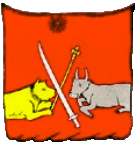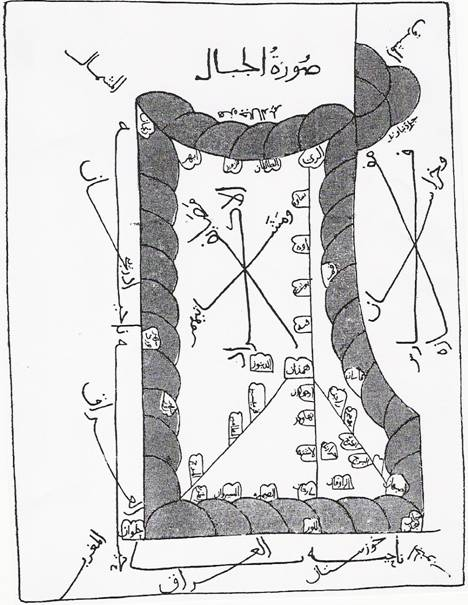|
John Macdonald Kinneir
Sir John Macdonald Kinneir (3 February 1782 – 11 June 1830) was a Scottish army officer of the East India Company, diplomat and traveller. Life Born at Carnden, Linlithgow, on 3 February 1782, Kinneir was the son of John Macdonald, comptroller of customs at Borrowstounness, and Cecilia Maria Kinneir. In 1802, he was nominated to a cadetship by Sir William Bensley, under the surname Macdonald, which was used in Indian army lists for the rest of his life. He published his books under the name Macdonald Kinneir. On 21 September 1804 Kinneir was appointed ensign in the Madras infantry, but was not posted until the formation of the 24th Madras Native Infantry on 1 January 1807, when he joined the new corps as lieutenant. He became captain in his regiment on 14 April 1818, and was later brevet lieutenant-colonel. For some time he was secretary to the officer commanding in Malabar and Kanara. Kinneir was attached to Sir John Malcolm's mission in Persia in 1808–9, during part of wh ... [...More Info...] [...Related Items...] OR: [Wikipedia] [Google] [Baidu] |
East India Company
The East India Company (EIC) was an English, and later British, joint-stock company founded in 1600 and dissolved in 1874. It was formed to trade in the Indian Ocean region, initially with the East Indies (the Indian subcontinent and Southeast Asia), and later with East Asia. The company seized control of large parts of the Indian subcontinent, colonised parts of Southeast Asia and Hong Kong. At its peak, the company was the largest corporation in the world. The EIC had its own armed forces in the form of the company's three Presidency armies, totalling about 260,000 soldiers, twice the size of the British army at the time. The operations of the company had a profound effect on the global balance of trade, almost single-handedly reversing the trend of eastward drain of Western bullion, seen since Roman times. Originally chartered as the "Governor and Company of Merchants of London Trading into the East-Indies", the company rose to account for half of the world's trade duri ... [...More Info...] [...Related Items...] OR: [Wikipedia] [Google] [Baidu] |
Neil Campbell (British Army Officer)
Major-General Sir Neil Campbell CB (1 May 1776 – 14 August 1827) was a British Army officer who fought during the Napoleonic Wars, administered several British colonies, and escorted Napoleon Bonaparte into exile. Biography Born on 1 May 1776, Campbell was the son of a British Army officer. Early career In 1797, Campbell purchased his first commission in the Army as an ensign with a regiment stationed in the Turks and Caicos Islands. In 1799, Campbell purchased a lieutenancy. In 1800, Campbell returned to England and joined a regiment of light troops there. From February 1802 to September 1803, he attended the Royal Military College, then located at Great Marlow. After his time at the college, Campbell became an assistant quartermaster-general. In 1805, Campbell purchased a promotion to major in a regiment that spent two years in Jamaica. After returning to England, Campbell purchased a promotion to lieutenant colonel. Over the next three years, Campbell participated in ... [...More Info...] [...Related Items...] OR: [Wikipedia] [Google] [Baidu] |
Tabriz
Tabriz ( fa, تبریز ; ) is a city in northwestern Iran, serving as the capital of East Azerbaijan Province. It is the List of largest cities of Iran, sixth-most-populous city in Iran. In the Quri Chay, Quru River valley in Iran's historic Azerbaijan (Iran), Azerbaijan region between long ridges of volcanic cones in the Sahand and Eynali mountains, Tabriz's elevation ranges between above sea level. The valley opens up into a plain that gently slopes down to the eastern shores of Lake Urmia, to the west. With cold winters and temperate summers, Tabriz is considered a summer resort. It was named World Carpet Weaving City by the World Crafts Council in October 2015 and Exemplary Tourist City of 2018 by the Organisation of Islamic Cooperation. With a population of over 1.7 million (2016), Tabriz is the largest economic hub and metropolitan area in northwest Iran. The population is bilingual, speaking Azerbaijani language, Azerbaijani and Persian. Tabriz is a major heavy industrie ... [...More Info...] [...Related Items...] OR: [Wikipedia] [Google] [Baidu] |
Ivan Paskievich
Count Ivan Fyodorovich Paskevich-Erevansky, Serene Prince of Warsaw (russian: Ива́н Фёдорович Паске́вич-Эриванский, светлейший князь Варшавский, Romanization of Russian, tr. ; – ) was an Russian Empire, Imperial Russian military leader of Zaporozhian Cossacks, Cossack origin who was the Namiestnik of Poland. Paskevich is known for leading Russian forces in Poland during the November Uprising, November uprising and for a series of leadership roles throughout the early and mid-19th century, such as the Russo-Persian War (1826–28) and the beginning phase of the Crimean War. Paskevich started as an officer during the Napoleonic wars serving in the battles of Battle of Austerlitz, Austerlitz and Battle of Borodino, Borodino. After the war, he was a leader in the Russo-Persian War (1826–28). He was made Count of Yerevan in 1828. Afterward, he became Namiestnik of Poland in 1831 after he crushed the Polish rebels in the ... [...More Info...] [...Related Items...] OR: [Wikipedia] [Google] [Baidu] |
Erivan Fortress
Erivan Fortress ( hy, Երևանի բերդը; ''Yerevani berdë''; fa, قلعه ایروان, ''Ghaleh-ye Iravân''; russian: Эриванская крепость ''E'rivanskaya krepost' '') was a 16th-century fortress in Yerevan. History The fortress was built during the Ottoman rule in 1582–83 by Serdar Ferhat Pasha. The fortress was destroyed by an earthquake in 1679. After the earthquake, the Safavid governor of Erivan, Zal Khan, asked the Shah for help to rebuild Erivan, including the fortress and the Palace of the Sardars. On 12 July 1679, the Safavid vice-regent of Azerbaijan (historic Azerbaijan, also known as ''Iranian Azerbaijan''), Mirza Ibrahim, visited Erivan. He was directed to recover the fortress, the seat of the governor of Erivan. Many villagers from Ganja, Agulis and Dasht (Nakhchivan) were moved to Erivan to rebuild the fortress. The forced labor continued until winter. Later, the Shah allowed everyone to return to their homes. The reconstruction o ... [...More Info...] [...Related Items...] OR: [Wikipedia] [Google] [Baidu] |
Russo-Persian War (1826–28)
The Russo-Persian Wars or Russo-Iranian Wars were a series of conflicts between 1651 and 1828, concerning Persia (Iran) and the Russian Empire. Russia and Persia fought these wars over disputed governance of territories and countries in the Caucasus. The main territories disputed were Aran, Georgia and Armenia, as well as much of Dagestan – generally referred to as Transcaucasia – and considered part of the Safavid Iran prior to the Russo-Persian Wars. Over the course of the five Russo-Persian Wars, the governance of these regions transferred between the two empires. Between the Second and Third Russo-Persian Wars, there was an interbellum period in which a number of treaties were drawn up between the Russian and the Persian Empires, as well as between both parties and the Ottoman Empire. Ottoman interest in these territories further complicated the wars, with both sides forming alliances with the Ottoman Empire at different points throughout the wars. Following the Treat ... [...More Info...] [...Related Items...] OR: [Wikipedia] [Google] [Baidu] |
Ahar
Ahar ( fa, italic=yes, اهر, az, اهر) is a city and capital of Ahar County, East Azerbaijan Province, Iran. According to the 2016 census, Ahar was the fourth most populated city of the province with a population of 100,641 in 20,844 families. Ahar was the capital of Karadag Khanate in 18th and 19th centuries. Situation In the wake of Russo-Persian War (1804–13) Ahar, with 3500 inhabitants, was the only city of Qaradağ. Around the mid 1830s the population was estimated to be from five to six thousand inhabitants in about six hundred houses. By 1956 the population had increased to 19816. At the 2016 census, its population was 100,641, in 20,844 families. Despite this population boom the city has been losing its former importance to the much smaller neighboring Kaleybar city as the later is gaining nationwide fame as a tourist destination. History Ahar is one of the ancient cities of Azerbaijan, its name before Islam was "meimad". In the 12th-13th centuries, Ahar was ... [...More Info...] [...Related Items...] OR: [Wikipedia] [Google] [Baidu] |
Fath-Ali Shah Qajar
Fath-Ali Shah Qajar ( fa, فتحعلىشاه قاجار, Fatḥ-ʻAli Šâh Qâjâr; May 1769 – 24 October 1834) was the second Shah (king) of Qajar Iran. He reigned from 17 June 1797 until his death on 24 October 1834. His reign saw the irrevocable ceding of Iran's northern territories in the Caucasus, comprising what is nowadays Georgia, Dagestan, Azerbaijan, and Armenia, to the Russian Empire following the Russo-Persian Wars of 1804–1813 and 1826–1828 and the resulting treaties of Gulistan and Turkmenchay. Historian Joseph M. Upton says that he "is famous among Iranians for three things: his exceptionally long beard, his wasp-like waist, and his progeny." At the end of his reign, his difficult economic problems and military and technological liabilities took Iran to the verge of governmental disintegration, which was quickened by a consequent struggle for the throne after his death. Under Fath-Ali Shah, many visual portrayals of himself and his court were created i ... [...More Info...] [...Related Items...] OR: [Wikipedia] [Google] [Baidu] |
Nawab Of The Carnatic
The Carnatic Sultanate was a kingdom in South India between about 1690 and 1855, and was under the legal purview of the Nizam of Hyderabad, until their demise. They initially had their capital at Arcot in the present-day Indian state of Tamil Nadu. Their rule is an important period in the history of the Carnatic and Coromandel Coast regions, in which the Mughal Empire gave way to the rising influence of the Maratha Empire, and later the emergence of the British Raj. Borders The old province known as the Carnatic, in which Madras (Chennai) was situated, extended from the Krishna river to the Kaveri river, and was bounded on the West by Mysore kingdom and Dindigul, (which formed part of the Sultanate of Mysore). The Northern portion was known as the ' Mughal Carnatic', the Southern the 'Maratha Carnatic' with the Maratha fortresses of Gingee and Ranjankudi. Carnatic thus was the name commonly given to the region of Southern India that stretches from the East Godavari of An ... [...More Info...] [...Related Items...] OR: [Wikipedia] [Google] [Baidu] |
Fort St George, Madras
Fort St. George (or historically, White Town) is a fortress in the coastal city of Chennai, India. Founded in 1639, it was the first English (later British) fortress in India. The construction of the fort provided the impetus for further settlements and trading activity, in what was originally an uninhabited land. Thus, it is a feasible contention to say that the city (formerly named Madras) evolved around the fortress. The fort currently houses the Tamil Nadu legislative assembly and other official buildings. History The East India Company (EIC), which had entered India around 1600 for trading activities, had begun licensed trading at Surat, which was its initial bastion. However, to secure its trade lines and commercial interests in the spice trade, it felt the necessity of a port closer to the Malaccan Straits, and succeeded in purchasing a piece of coastal land, originally called ''Chennirayarpattinam'' or ''Channapatnam'', where the Company began the construction of ... [...More Info...] [...Related Items...] OR: [Wikipedia] [Google] [Baidu] |
Bombay
Mumbai (, ; also known as Bombay — the official name until 1995) is the capital city of the Indian state of Maharashtra and the ''de facto'' financial centre of India. According to the United Nations, as of 2018, Mumbai is the second-most populous city in India after Delhi and the eighth-most populous city in the world with a population of roughly 20 million (2 crore). As per the Indian government population census of 2011, Mumbai was the most populous city in India with an estimated city proper population of 12.5 million (1.25 crore) living under the Brihanmumbai Municipal Corporation. Mumbai is the centre of the Mumbai Metropolitan Region, the sixth most populous metropolitan area in the world with a population of over 23 million (2.3 crore). Mumbai lies on the Konkan coast on the west coast of India and has a deep natural harbour. In 2008, Mumbai was named an alpha world city. It has the highest number of millionaires and billionaires among all cities i ... [...More Info...] [...Related Items...] OR: [Wikipedia] [Google] [Baidu] |
Kurdistan
Kurdistan ( ku, کوردستان ,Kurdistan ; lit. "land of the Kurds") or Greater Kurdistan is a roughly defined geo-cultural territory in Western Asia wherein the Kurds form a prominent majority population and the Kurdish culture, Kurdish languages, languages, and national identity have historically been based. Geographically, Kurdistan roughly encompasses the northwestern Zagros Mountains, Zagros and the eastern Taurus Mountains, Taurus mountain ranges. Kurdistan generally comprises the following four regions: southeastern Turkey (Turkish Kurdistan, Northern Kurdistan), northern Iraq (Iraqi Kurdistan, Southern Kurdistan), northwestern Iran (Iranian Kurdistan, Eastern Kurdistan), and northern Syria (Syrian Kurdistan, Western Kurdistan). Some definitions also include parts of southern South Caucasus, Transcaucasia. Certain Kurdish nationalism, Kurdish nationalist organizations seek to create an independent nation state consisting of some or all of these areas with a Kurdish ma ... [...More Info...] [...Related Items...] OR: [Wikipedia] [Google] [Baidu] |



.jpg)





